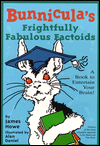Below is a portion of the adverbial section highlighting because. Although so that has a similar meaning, I thought it best to present the adverbial because alone in a sentence scramble because so that requires a change in verb structure.
This type of exercise requires that students really understand parts of speech to figure out the sentence order and having read the book, they use the context of the story to make sense of the scramble. Again, these are original sentences, and I typically present them so that they follow the order of the story. If the teacher wants to assign half the worksheet, s/he can. This type of challenging exercise can be started in class as pair work with the remainder assigned for homework.
Chester stays awake at night because Bunnicula suspicious is of he.
Harold likes to hang out in Toby’s room because cupcakes shares he chocolate his.
Pete thinks that the vegetables are turning white because with being they sprayed are
chemicals.
Mrs. Monroe thought Chester was acting strange because love needs attention and he.
Mrs. Monroe washed Chester in the sink with soap because garlic he of smelled.
Chester threw the water dish at Bunnicula because and shrivel he that water vampires
disappear read makes.
Harold ran over to Toby and barked because to wanted warn he that sick
Bunnicula was him. Another part of this packet includes a fairly comprehensive list of the book's vocabulary categorized by parts of speech and including page numbers. This chart could be printed on cardstock and used as bookmarks as students read along. Included in this Contextualized Grammar Review is an 18-item worksheet with original sentences asking students to identify adjectives, adverbs, nouns, and verbs. Some of the vocabulary is found in this Parts of Speech worksheet as well as in other exercises throughout this packet.
As always, comments and feedback are welcome!


